#country marlborough
Text

#stately home#country house#interior#architecture#library#higginsandcole#england#blenheim palace#Duke of Marlborough
189 notes
·
View notes
Text
my ldr album is so sexy esp the title cuz it literally fits in SO well w the rest of her discog
#born 2 die. honeymoon. chemtrails over the country club. marlborough diamonds. lust for life. ultraviolence. whers the one i made up lol#kidding but like. idk im sooo proud of myself#xoxo
1 note
·
View note
Text

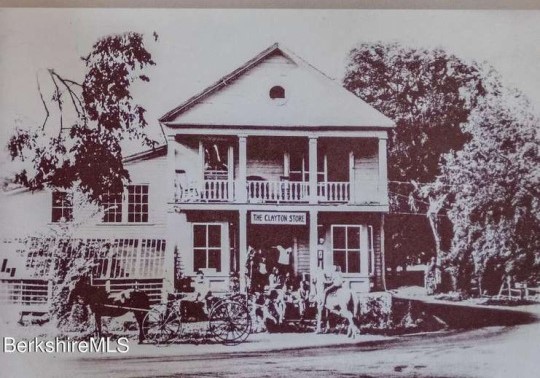
What a wonderful 1810 home/historic store in Marlborough, Massachusetts. The Clayton Store is now a second story residence, an attached studio, and a recreated country store from 1850 on the ground floor. 2bd, 1.5ba, $590K (a bargain!). Look at this place!



This is the residence on the 2nd floor.


How sweet is this kitchen?

Beautiful primary bedroom.
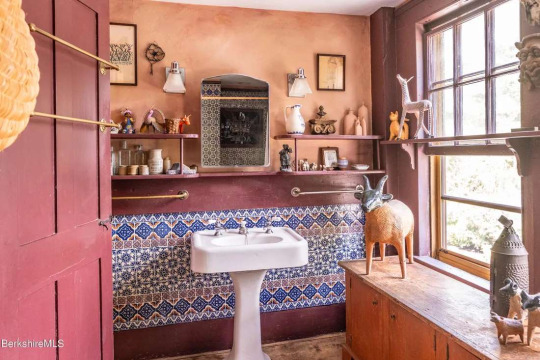
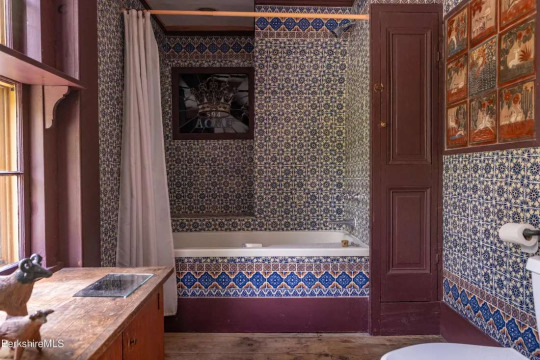
What great tile in the bath.

In this part of the home are the entrances to the store and studio.


The studio is up the stairs and the store (the back entrance) is straight ahead.

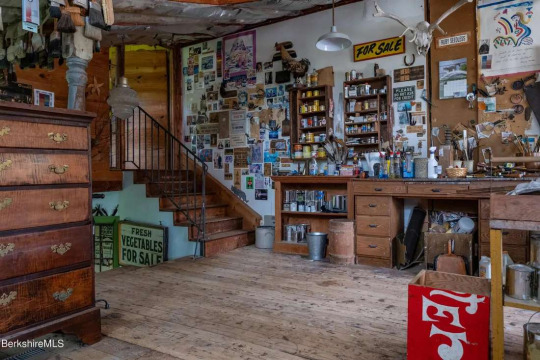
The studio. The current owner is a collector and a professional decorative painter.

Isn't the store fabulous? Look at this stove, the coffee grinder, the bins in front of the counter...


Here we have some squash and stuff behind the counter.

Dry goods dept.

Isn't this like living in a museum?



1.78 acres of beautiful land, too.
89 notes
·
View notes
Text
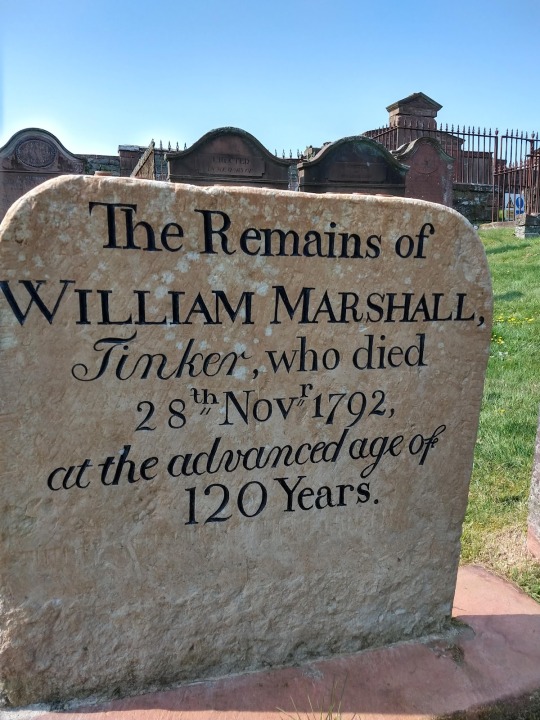


Billy Marshall, King of the Galloway Tinker Gypsies died on 28th November 1792, allegedly at the age of 120 years.
Billy Marshall fought at the Battle of the Boyne and deserted the army seven times and the Royal Navy three times during his eventful 120 years on earth
The oldest man recorded in modern history books — one Jiroemon Kimura of Japan — reached 116 years, 54 days. But even this grand old age doesn't beat the oldest ever Scotsman, who is said to have lived for more than 120 years. What's more, William 'Billy' Marshall was around long before the age of modern medicine and at a time when average life expectancy was less than 50 years.
Marshall died on this day in 1792 and his tombstone in St Cuthbert's churchyard in Kirkcudbright records that he reached the 'advanced age of 120 years'.
It also records his occupation as 'tinker' although he was also known as the 'King of the Gypsies', the 'King of the Randies' and the 'Caird of Barullion'. Billy was also a bare knuckle boxer, a smuggler, a soldier who deserted seven times and a sailor who deserted three times.
He was married 17 times and was the father of 68 children, including four reputedly after his 100th birthday.
Billy is said to have fought with William of Orange at the Battle of the Boyne in 1690 and more than once with the Duke of Marlborough at Flanders during the Nine Years War (1688-1697).
However, he deserted each year, no matter where he was, in order to attend Keltonhill Fair, two miles from Castle Douglas. The Horse Fair was the highlight of the gypsy year, and Billy claimed not to have missed one in a 100 years.
According to an entry in the New Annual Register for 1792: "This miracle of longevity retained his senses almost to the last hour of his life. He remembered distinctly to have seen King William's Fleet, when on their way to Ireland, riding at anchor in the Solway Firth close by the bay of Kirkcudbright, and the transports lying in the harbour.
"He was present at the siege of Derry (in 1689), where having lost his uncle, who commanded a King's frigate, he returned home, enlisted in the Dutch service, went to Holland and soon after deserted, and came back to his native country.
"Naturally of a wandering and unsettled turn of mind, he could never remain long in any particular place. Hence he took up the occupation of a tinker, headed a body of lawless bandits and frequently traversed the kingdom from one end to the other. But it is to be observed to his credit that all the thieving wandering geniuses who, during the weakness of the established government, led forth their various gangs to plunder and to alarm the country, he was far the most honourable in his profession."
Having served as a soldier, he was able to organise the country people who lost land when landowners built stone dykes and walls and went round knocking them down.
He was a skilled horner, giving him the name 'Caird of Barullion' - a ceardon being a gypsy word for a skilled worker who practices some trade or handicraft and Barullion being his homeland in Galloway.
Several examples of his work made of cow, sheep and goat horn at the Museum of Kirkcudbright. One of the spoons has a twisted handle and is inscribed 'W x M 115 1788' — his initials, age and the date.
43 notes
·
View notes
Text

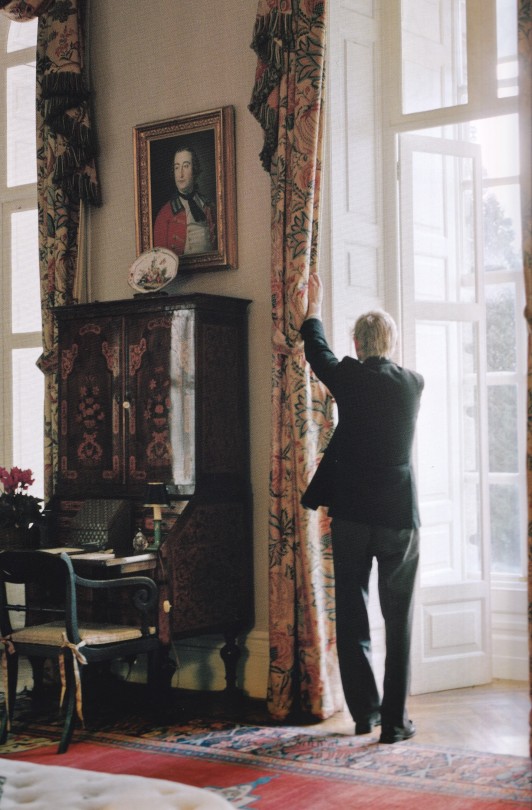



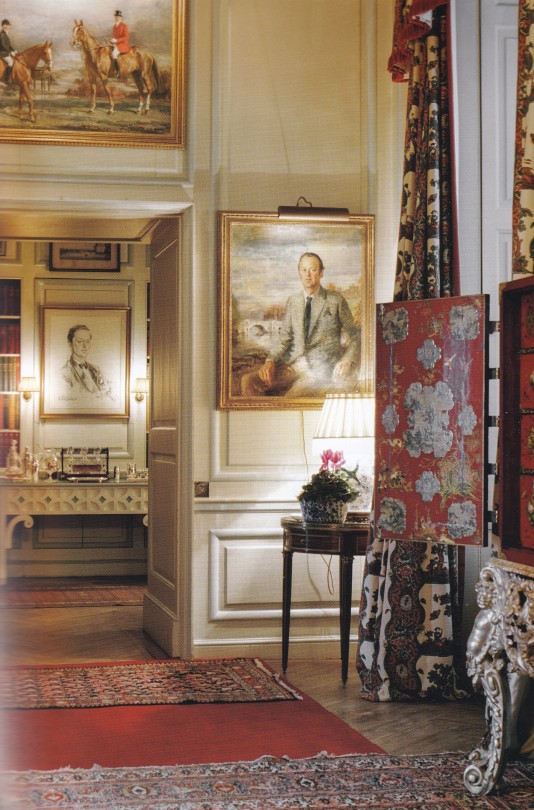
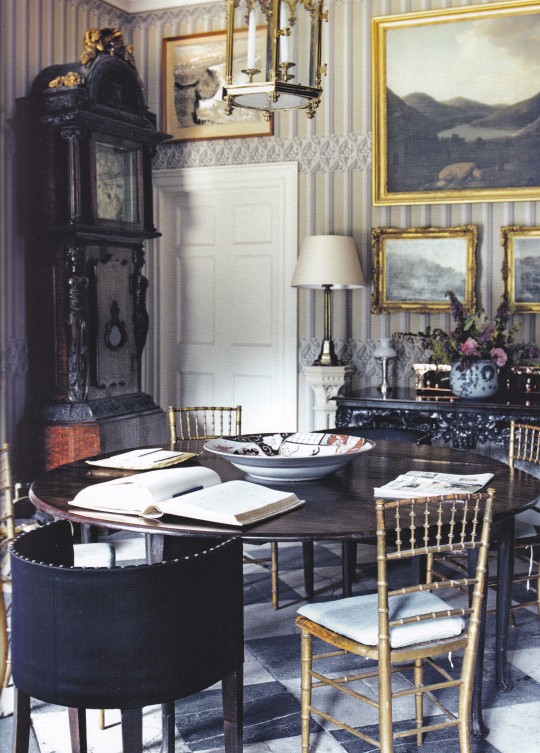
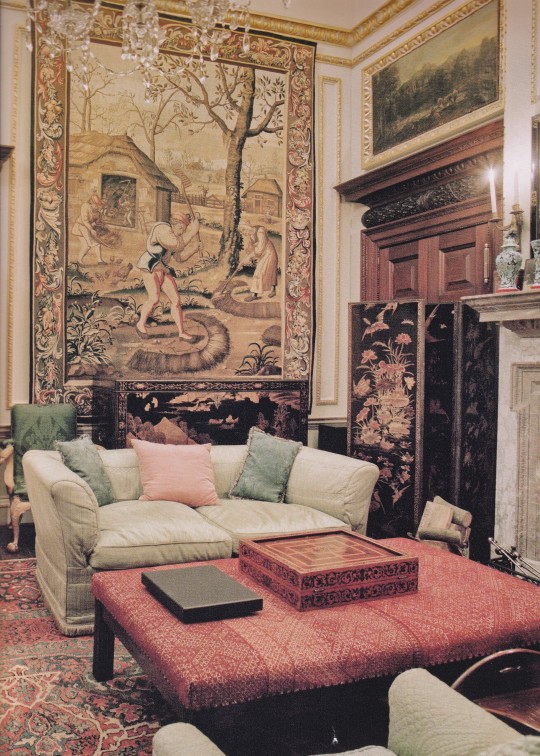

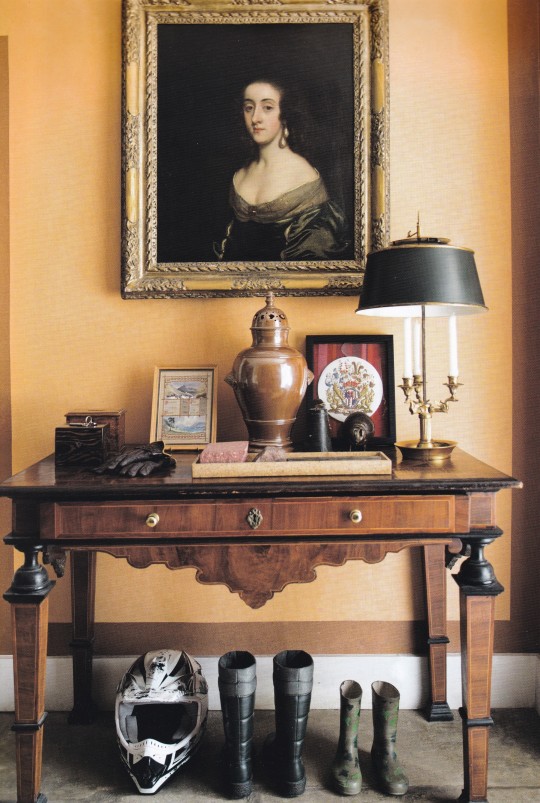
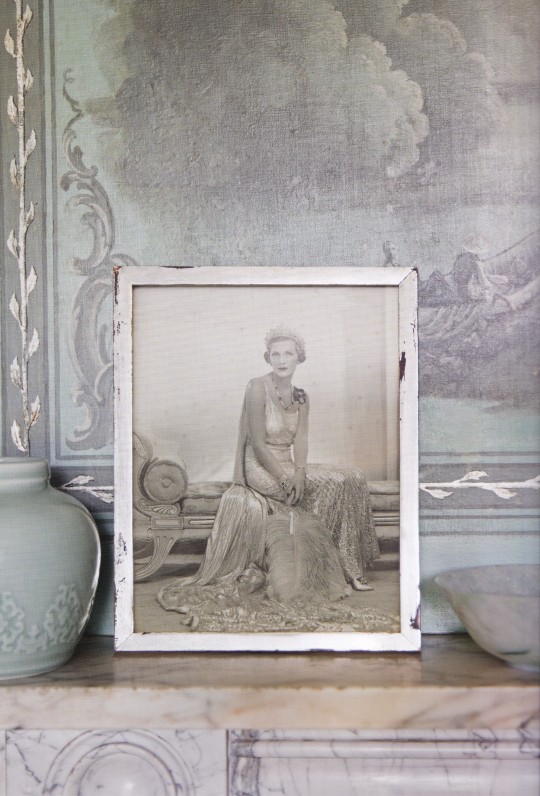
Great Houses Modern Aristocrats
by James Reginato
Photographs by Jonathan Becker, Foreword by Viscount Linley
Rizzoli Int., New York 2016, 256 pages, Hardcover, ISBN 978-0-8478-4898-0
euro 70,00
email if you want to buy [email protected]
This stunning book presents the intriguing stories and celebrated histories of some of the leading families of Great Britain and Ireland and the opulent residences that have defined their heritages. The history of England is inextricably linked with the stories of its leading aristocratic dynasties and the great seats they have occupied for centuries. As the current owners speak of the critical roles their ancestors have played in the nation, they bring history alive. All of these houses have survived great wars, economic upheavals, and, at times, scandal. Filled with stunning photography, this book is a remarkably intimate and lively look inside some of Britain’s stateliest houses, with the modern-day aristocrats who live in them and keep them going in high style. This book presents a tour of some of England’s finest residences, with many of the interiors shown here for the first time. It includes Blenheim Palace—seven acres under one roof, eclipsing the splendor of any of the British royal family’s residences—property of the Dukes of Marlborough; the exquisite Old Vicarage in Derbyshire, last residence of the late Dowager Duchess of Devonshire (née Deborah Mitford); Haddon Hall, a vast crenellated 900-year-old manor house belonging to the Dukes of Rutland that has been called the most romantic house in England; and the island paradises on Mustique and St. Lucia of the 3rd Baron Glenconner. This book is perfect for history buffs and lovers of traditional interior design and English country life.
22/02/24
#Great Houses#Modern Aristocrats#leading english families#finest english residences#traditional interior design#English Country Life#designbooksmilano#fashionbooksmilano
8 notes
·
View notes
Text
Thanks to a certain someone, I dove down a rabbit hole of finding a modern-day birthday that would work for my Elwin/Miles.
November 14th! Not only is that Scorpio, but it's also apparently the birthday of King William III of England.
No, I absolutely did not just sit here and do a quick skim through various Google results to see if this specific reference would at all be appropriate, and you know what, we're sticking with it.
Some completely useless info about William III below the cut, because I have lost control of my life(as usual) and I Just Think It's Neat. Not by any means a 1:1 comparison, but:
Holland, by the time of William’s death, was ceasing to be a great power, for reasons for which he cannot be held responsible. That it remained free, independent, and prosperous was in no small measure due to him. In England he remained to the last an alien, unpopular with the ruling classes, though the common people always looked on him as the Protestant hero and hailed his appearances with enthusiasm.
His reign was of great importance in the constitutional history of the country, and his own contribution to these developments was far from negligible. By moderation and good faith in his exercise of the royal prerogative, he preserved the crown and with it those elements of stability and continuity that have been the peculiar strength of Great Britain. William hated faction, and his influence brought to an end a long period of murderous party strife. He sponsored the reform of the currency and promoted the Irish linen trade. The Toleration Act (1689) fell short of his wishes, but in spite of many frustrations he did his utmost to promote religious toleration. In 1689, of his own free will, he granted independence to the judiciary, a grant later given statutory permanence by the Act of Settlement (1700–01).
Contemporaries acclaimed William a great soldier, although he was not, in fact, a very fortunate general. But the Dutch and British armies that Marlborough inherited to continue the war against Louis were at least in part his creation. Though a martinet with his soldiers, he won and kept their devotion by his personal bravery and his concern for their well-being. A life of gruelling public activities left him little leisure for other pursuits, but he deserves mention as a patron of the arts. On his private estates he was an enlightened lord of the manor in his concern for the welfare of his tenants and the maintenance of his lands; in his private charities he was particularly concerned to help refugees.
#Headcanons#I do firmly headcanon that my Elwin was a great general unlike William III apparently#but still! this little detour into reading up on historical figures turned out to be super fun
6 notes
·
View notes
Text

Well, I'm not sure I'll ever understand the American obsession with the new. Like everything has to be new, new, new. Well... that's one of the reasons I like this country. It's young... Mmm, thank you. It's eager. It's constantly looking towards the future.
You know, I've been thinking. Will you pass me some toast? Thanks. I'd like to apply for citizenship. Really? Well, I've lived all over the world, and I've never really had a strong attachment to England.
And I-I want our child to have a-a real home. Our child...
Since when were you never attached to England? Can you walk away from your heritage that easily? Hastings and "Magna Carta", Drake, Marlborough; the Tudors, Stuarts, the Plantagenets. These are things I fought a-a war for.
It's just something I want to do. Well, there's no need. My employment provides us both with residency indefinitely. That's not what this is about. No. It's not what this is about. It's about that. ( Shaky breath ) A wife who won't let me touch her. Admit it. You are using this pregnancy to keep me at a distance. You have retreated further and further into your shell ever since we got here. I'm sorry. Don't walk away, Claire. It is time we dealt with this like adults. As opposed to the way that I've been dealing with it? Please stop! Stop... And talk to me.
And say what, Frank? What is it that you want from me? I want to know when you're going to come back from the fսck¡ng past! You asked me to leave behind everything that truly mattered to me! And yet it's fine for you to go on about the things that you've missed in the good old days. "Never talk about the past." That was the bargain. And I've kept that bargain to the letter. No, the bargain was that we raise this baby together. Our child. It hasn't even been born yet, and you will not let me in... let alone touch you, God forbid. Is it sеx? Is that what this is? When you need a good fսck and you can't find one? Well, I hear there's some lovely girls at Radcliffe who would just die over your English accent. Well, I'm not the one who's been fսck¡ng other people. I didn't force this bargain on you, Claire. I didn't force you to come to Boston. And I'm not forcing you to stay. I never thought otherwise. Go... or stay. But please... do it because it's what you really want to do.
#outlander#outlanderedit#outlander series#outlander starz#outlander fanart#caitrionabalfe#claire beauchamp#claire fraser#caitriona balfe#tobias menzies#frank randall#outlander books#outlander season 3#outlander 3x01
9 notes
·
View notes
Text


What gave to this country the advantage in the war of the Spanish Succession was the genius and the overwhelming personal ascendency of Marlborough. ... It is due to him that England became one of the great Powers of the world, and next to France, the first of Powers.” - Lord Acton
What are your opinions on John Churchill, the Duke of Marlborough. Brother in law to the last Catholic King of England, James II. He owes to high rank to him, though he betrayed him against William of Orange.
2 notes
·
View notes
Note
for the History ask game- asking for 1,3, 13, 14, 20,27, 28, 29, 30? - antebellumite
woahhhhhhh thank you for the ask!
1. Who's my fav?? CHARLES TALBOT DUKE OF SHREWSBURY!!!!
3. What is your country most infamous for in history? Well... America has uh.. there is a LOT of shit that has been done. Can't just name one. Slavery, displacement of Natives, massacres, etc.
13. random thing about random historical person(people) in random era. UH uH ujh least crazy England Restoration Era story: Charles Sackville and his pookie Charles Sedley pulled up to a balcony naked, mimicked very lewd things(i like to think they actually fucked[see: homosexual], but people think they were just 'demonstrating sex'), blasphemed😨🤓😤🥶🙏🙏, and drank a toast to king Charles with wine Sedley dipped his penis in.
14. why do I like history?? It's just... idk cuz it's like we'll never know the full story, their full person, every single detail of their life, their thoughts, who they met and who they didn't (but more importantly who they fucked and who they didn't) and I get to fill in all those blanks with either logical guesses or the craziest AU EVER??? But also because i get to learn about what made this country what made that country why is the government like this yada yada.
20. History crush? CHARLES TALBOT DUKE OF SHREWSBURY LETS GOOOO!! HE IS SO GIRLFAILURE 😤😤
27. Fav What If? I have too many but heres one: WHAT IF Frederick the Great did not get his ass saved by Petey the third. Prussia fuckin loses. what happens then?
28. DREAM TEAM?? Oh my shit theres so mANY! Honorable mentions: The Great Triumvirate and the Cabal Ministry of Charles II of England. Okay but for my favorite gangbang they don't have a definite group in the history books except they do because William of Orange's ministry or whatever: Thomas Osborne 1st Duke of Leeds, George Savile 1st Marquess of Halifax, Charles Montagu 1st Earl of Halifax, Robert Spencer 2nd Earl of Sunderland, William Cavendish 1st Duke of Devonshire, Charles Talbot 1st Duke of Shrewsbury!1!!111!1, Daniel Finch 2nd Earl of Nottingham, Charles Sackville 6th Earl of Dorset, Edward Russell 1st Earl of Orford, Charles Mordaunt 3rd Earl of Peterborough, Arthur Herbert 1st Earl of Torrington, John Churchill 1st Duke of Marlborough, Henry Sydney 1st Earl of Romney
I know there are other fellas out there working for Orange but this is my gangbang
29. Great historical mystery im interested in???I know nothin about great historical mysteries 😭 idk man history itself is very mysterious since there's a lot we don't know.
30. Ask a question of my own hmmmm... Apart from the 21st century, which time period would you live in?
#woooahoooo#this was such a silly#i liked doing this it made me think#for numero 13 i shuffled through so many scenarios trying to find a very silly one and here we go#literally anything that happened in Restoration England needs to be studied under a microscope#dig up their bones#unanchored ted talks 101#uh#history???#literally don't know what to tag this
2 notes
·
View notes
Text

#country house#stately home#interior#library#architecture#higginsandcole#england#preppy#dog#books#Blenheim palace#duke of marlborough
166 notes
·
View notes
Text


It is one of the country’s most prestigious public schools, a historic building on the edge of a pretty town that has educated everyone from poets to comedians – and now counts a future queen among its alumni.
Since it was founded in 1843 for the purpose of educating the sons of clergymen, the £42,930-per-year Marlborough College has seen artist William Morris, the poets John Betjeman and Siegfried Sassoon, and Samantha Cameron, wife of the former prime minister David Cameron, as well as funnyman Jack Whitehall pass through its halls and corridors.
And in 1996 – seven years after it became fully co-educational, having previously only admitted girls in the sixth form - it welcomed a princess-in-waiting, even if few might have guessed it at first.
The then 14-year-old Kate Middleton arrived in Marlborough, Wiltshire, as a shy and lanky teen, having moved after enduring alleged bullying at her previous school, Downe House.
It would prove to be an entrée into a world, which would eventually see her rubbing shoulders with a notably privileged group of students and see her secure a place at the ancient St Andrews University – where Prince William happened to be studying.
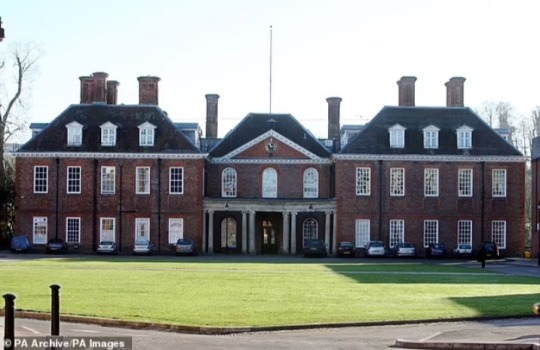
Such a trajectory seemed unlikely when she first arrived in rural Wiltshire, however.
‘She had very little confidence,’ recalled her dorm mate Gemma Williamson, who described the new arrival who joined in the middle of the year as 'thin and pale.'
Kate’s house tutor Joan Gall said she was suffering from eczema due to stress.
‘When she arrived, she was very quiet. Coming into a big school like Marlborough was difficult, but she settled in quickly.’
Miss Gall previously said: ‘It was like a big, happy family. We would do things like bake cakes and watch videos.’
Certainly, the girl who would go on to become a celebrated royal beauty did not initially catch the eye of male pupils, who would crudely give passing girls a score out of ten as they made their way to supper. Kate was given a mere two.
Yet during her four years at Marlborough, the future Princess of Wales blossomed into a beautiful, sought after young woman as well as an accomplished one who excelled at hockey and who would go on to become co-captain of the tennis team.
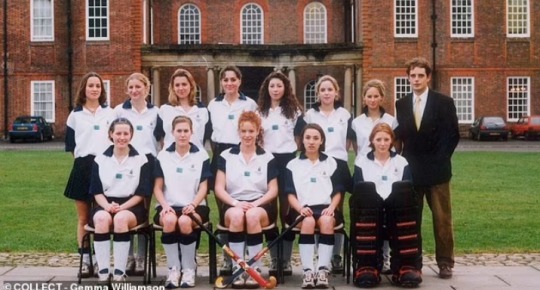

In fact, unlike her time at Downe House, Kate felt at home from the start of her time at Marlborough, where she joined the school's cosy all-girls boarding house, Elmhurst.
Contemporaries recall her as the perfect pupil, listening to her Walkman, watching Friends and indulging in Marmite sandwiches.
Meanwhile, housemistress Ann Patching recalled her former pupil's love of lasagne and pasta bakes but said that 'Kate always stayed very slim.’
Naturally kind hearted, she quickly gained a close circle of friends, among them her peers on the hockey team, one of whom accompanied her on a trip to Ibiza to recover from her heartbreak after she briefly broke up with Prince William in 2007.
Unfazed by her popularity however, she remained a responsible role model and was never caught with illicit booze unlike her friends, one of whom once confided:
'A group of us used to sneak off to Reading to go drinking but she would never join us.'
In fact, Kate was only charged with one lapse in good behaviour when she threw up on the train home after an all-night champagne and dance party hosted by a member of her hockey team.
It was after a hockey tour to Argentina, friends recall – followed by a family trip to the Caribbean - that a then 16-year-old Kate returned to the school sixth firm newly transformed.
‘She was an absolute beauty,‘ according to friend Gemma, who says 'boys now fancied her rotten.’
Among them was the comedian Jack Whitehall, who attended Marlborough a few years below Kate and who admitted in an interview that she was his first crush.
He later joked of being jealous of the attention the princess received from the school, venting:
''I went to the same secondary school as Kate Middleton and she's someone they like to talk about.
I've been sending them a letter each year saying maybe now it's time to put me in the school prospectus or on the walls. I feel like I'm their dirty little secret.'
Nonetheless, despite becoming a favoured among the boys, the princess did not have lengthy dalliances with the opposite sex.
'I got the distinct impression that Catherine wanted to save herself for someone special,' said Gemma previously.
Her first kiss is believed to have been with Woody, the elder brother of Alice St John Webster - one of Kate's closest friends.
She also reportedly had a brief romance with Harry Blakelock, captain of the rugby team, which fizzled out after he left school, leaving Kate 'heartbroken.'
There’s no question that Kate made quite an impact on her school, later hailed as 'Person most likely to be loved by everybody' in her yearbook, when she departed on her gap year before heading to University of St Andrews after achieving two As and a B in her A Levels.
By then, she had been followed to Marlborough by her younger sister Pippa who, untainted by earlier experiences of bullying, was seen by contemporaries as the more naturally confident half of the Middleton pair.
She enrolled at the same boarding house as her older sister and joined the hockey team, yet there was little in the way of sibling rivalry according to contemporaries.

In fact, along with friend Alice St John Webster, they are remembered as a tight trio.
'Alice, Pippa and Kate were a very tight group and all best friends from the age of 14 upwards. It could be a bit suffocating. They did everything together,' one friend said.
Riding a wave of success in the sporting and social spheres at prep school, Pippa won an all-rounder scholarship to Marlborough and became captain of the hockey team.
Unlike Kate's meek start at the college, Pippa took every opportunity to make an impression at the school, with one contemporary saying:
'Pippa was slightly tough and, back then, the one with the charisma. No one would ever think of bullying her.'
She was given the unfortunate nickname 'pan face' because of her supposed flat features but was not put off trying to impress her male peers, even when playing sport.
'My focus is on winning and making sure that my hair — fashioned into a slick Sporty Spice “up do” — is just right. Did I mention boys watching?' she wrote in the Spectator.
Seen as the 'alpha' sister in contrast to 'kind hearted, home-loving' Kate, Pippa 'loved being the centre of attention' according to one contemporary.
She was chatty, funny and louder than her sister but, despite her sociable nature, she followed Kate's example of dodging drinking and smoking.
Housemistress Ann Patching later described the relationship between the well-behaved pair saying:
'Pippa was good at everything and sharper academically, but I don’t think Catherine ever resented that.'
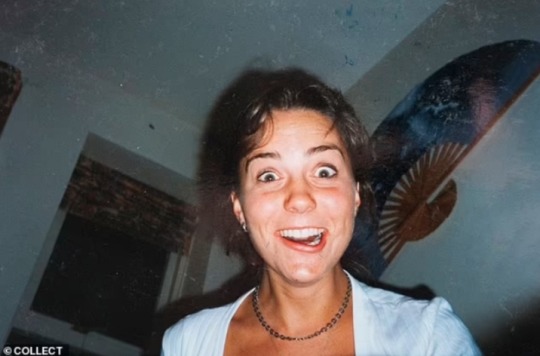
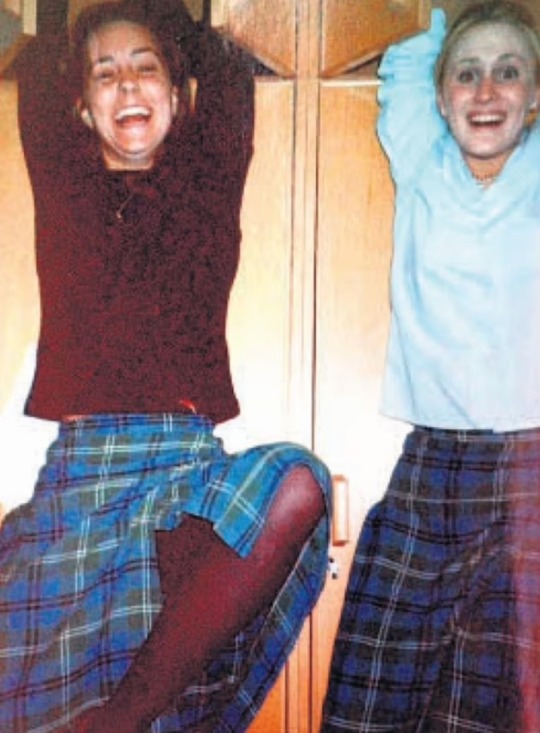
Twenty three years after Kate departed for the last time, meanwhile, there is no question that the school - with its serene setting amid two lakes, and boasting a competition swimming pool, cricket pavilion and international-standard athletics track - remains a popular destination for well-heeled parents.
According to the Which school guide, competition for places at the school increased after it became known as the alma mater of the Princess of Wales.
Nor has it stopped it being mired in the occasional scandal.
In 2016, some of the older pupils brought in a stripper to perform on the grounds, an act later branded 'inappropriate' by the school.
The boarding school was also criticised last year for not carrying out necessary safeguarding checks on teachers, after an Independent Schools Inspectorate (ISI) report revealed that checks including barred lists for prior criminal offences were not completed.
A spokesperson for the school said at the time:
'Since our compliance inspection, the college has upgraded the record-keeping processes highlighted in the ISI report.
'We have been keeping our parents informed and are looking forward to an early re-inspection.'
None of this is likely to deter the wealthy elite, many of whom will doubtless be anxious for their own offspring to attend a school that prepped the Princess of Wales for her royal calling – and if rumour has it, may also be set to educate her offspring.

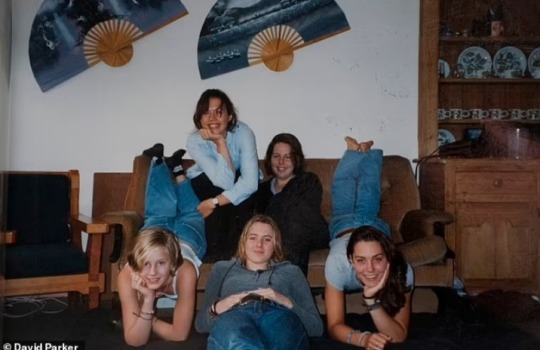
#Princess of Wales#Catherine Princess of Wales#Catherine Middleton#Kate Middleton#Marlborough College#St Andrews University#Downe House#Elmhurst#British Royal Family#Pippa Middleton
9 notes
·
View notes
Text
I'm not gonna lie, I loved writing this interaction 😂
(read the full chapter here!)
“So Stinky, have you heard anything from Marlborough Man?”
Rebecca half-smiled, trying not to show how much she secretly hated the nickname. “Nope.” She replied curtly, popping the ‘p’. “You?”
Sassy sunk into the plush velvet cushions on Rebecca’s couch and exhaled loudly, drawing out the word “Noooo.” She shook her head. “No, no, no. Zero. Zilch. Nada. Classic smash and dash.” She paused wistfully. “Never had a man leave the fucking country just to avoid ever having sex again though.”
“There’s a first time for everything.” Rebecca quipped. “Anyway, I thought you were the one who ended things?”
“Oh, I did. He was a mess. Tragic, really. Did I ever tell you he had an absolutely massive d-”
Rebecca’s hand shot up. “That’s too much information, Sass.”
7 notes
·
View notes
Text
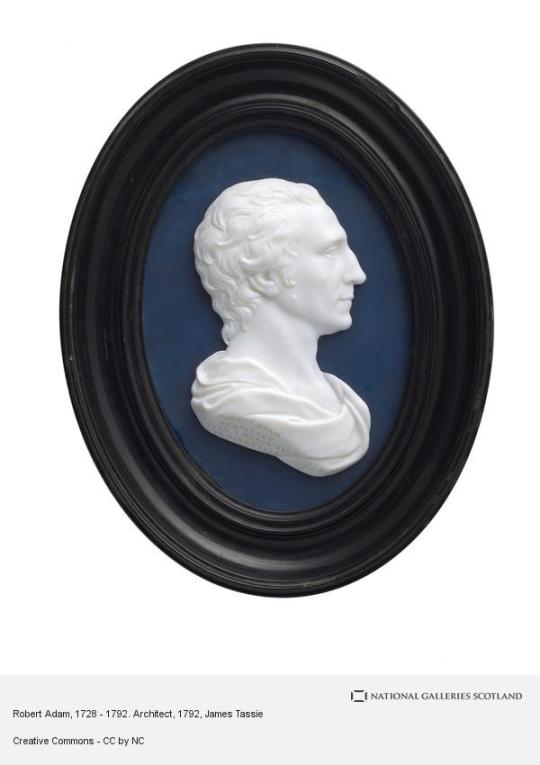



On July 3rd 1728 Robert Adam, the Scottish architect, furniture and interior designer, was born in Kircaldy
Robert Adam was the son of a Stonemason, William a stonemason who took up architecture, the family moved to Edinburgh when Robert was eleven, where his father had become the most popular architect in Scotland.
He attended The Royal High School in Edinburgh and was noted as having a "feeble constitution" His education continued at The University of Edinburgh where his studies were interrupted in 1745 due to wee bit of upheaval when the Jacobite Army of BPC arrived and occupied the City. Added to this he fell seriously ill at the end on the year and failed to graduate. On his recovery from illness in 1746, he joined his elder brother John as apprentice to his father. He assisted his father on projects such as the building of Inveraray Castle and the continuing extensions of Hopetoun House, his father died in 1748 and Robert and his brother ran the family firm now called Adam Brothers.
In 1750 Robert decided he needed to witness the architecture around Europe and departed on his "Grand Tour" in France and Italy. He studied widely the classical Roman ruins and increased his drawing skills.
On his return he opened his own architectural practice in London and soon became established as one of the most fashionable designers amongst the High Society. His Practice was timely as there was a renewed interest in England for all things Classical and the “Palladian Movement” (Based on the proportional architecture of the Italian Andrea Palladio) had just firmly taken hold. Adam was no slavish Palladian however and his Style has become known as “neoclassical”. He adapted and developed ancient styles rather than simply copying them.
As Adam was more often than not asked to renovate existing buildings much of his work was concerned with interiors. He was obsessive over every detail and designed everything himself down to plasterwork and fireplaces. He moved beyond Roman Style and was influenced by Greek, Byzantine and Italian Baroque design.
Adams work in Scotland include the Royal Exchange, in Edinburgh's High Street on the Royal Mile, The Royal Infirmary, Glasgow, Register House, Edinburgh and The Old College quadrangle at the University of Edinburgh.
In England he designed my favourite, Pulteney Bridge in Bath, as well as Kedleston Hall and Marlborough House, Brighton.
I think I have featured most of these buildings previously in posts so would like to showcase some of the meticulous interior work that Robert Adam was known for. As I've said before I am not a fan of the country houses, the places that reek of wealth, give me a ruined castle any day, but you have to admire the work that went into these interiors.
As seen in the first picture, Kenwood Library was added to Kenwood house in London by Adam between 1767-69 and you have to admit, it is beautiful as is The Marble Hall at Kedleston Hall, both these are open to visitors through English Heritage and National Trust respectively. Back in Scotland I couldn't finish this post without mentioning Red Drawing Dining room at Hopetoun House, made famous by the fictional Duke of Sandringham in TV Series Outlander.
13 notes
·
View notes
Text
Four men were charged over the alleged theft of a gold toilet valued at $5.95 million, the Crown Prosecution Service (CPS) said Monday.
Italian conceptual artist Maurizio Cattelan’s piece, titled “America”, vanished overnight in 2019 while on display at the birthplace and ancestral home of Winston Churchill. The fully functioning 18-carat gold toilet — created as a pointed social commentary on excessive wealth and greed — was part of an art installation at Blenheim Palace, near the city of Oxford.
At the time, local police said that the theft caused "significant damage and flooding" because the toilet had been connected to the palace plumbing system. The country house, built in Oxfordshire, England, in the early 1700s, is the principal residence of the Dukes of Marlborough.
The four men, who are accused of burglary and conspiracy to transfer criminal property, will appear at Oxford Magistrates' Court on Nov. 28, 2023.
Cattelan also created that duct-taped banana that went viral in 2019 after going on display at Art Basel in Miami.
______________
Ok so it was a art project not something that was actually ever there and in use.
That's far less awful.
6 notes
·
View notes
Photo
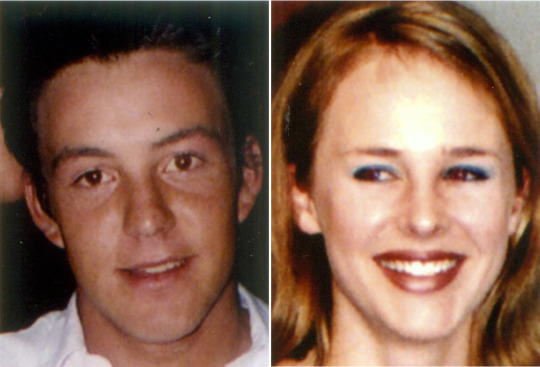
Ben Smart and Olivia Hope: New Year’s Murders
Ben Smart and Olivia Hope, two young New Zealanders, disappeared in the early hours of the morning on New Year's Day, 1 January 1998. The two friends had been celebrating on New Year's Eve at Furneaux Lodge in the Marlborough Sounds with 1500–2000 other partygoers.
Hope had travelled to the lodge with a group on a chartered yacht, Tamarack, while Smart had arrived separately. At about 4:00 a.m., lodge bartender Guy Wallace drove Hope and Smart in his water taxi to Tamarack, where the pair intended to sleep. When Hope and Smart found there were no vacant berths remaining aboard Tamarack, they re-boarded Wallace's water-taxi. At the time, Wallace had three other passengers on board: Hayden Morresey, Sarah Dyer, and a single man who would become crucial to the police investigation. The single man offered the pair a place to sleep on what he said was his yacht. Wallace let Smart and Hope off with the single man at the yacht, and then dropped off the two other passengers at their bach. This was the last time Smart and Hope were seen alive.
Ben Smart and Olivia Hope were reported missing on 2 January 1998. Initially the Blenheim police treated the investigation as a missing-persons case, but it soon became apparent that the disappearance was suspicious and out of character for the duo. The investigation was named "Operation TAM" (short for Tamarack) and generated widespread interest from the public and media. The investigation was large in scope, featuring requests for information from the public, significant amounts of interviews across the country and months of extensive searches of the waters surrounding the Endeavour Inlet. Despite this, no bodies were ever found.
With little to go on, police began trying to determine the identity of the unknown or 'mystery' man that offered Ben and Olivia a place to sleep on his boat. Police claimed that there were a number of descriptions of Scott Watson earlier in the night that were similar to descriptions of the unknown man. These descriptions depicted Watson as having a scruffy look that night, saying he had wavy hair, and needed a shave/haircut. However, a photograph of Watson, taken on the Mina Cornelia yacht where he partied before heading to Furneaux Lodge, shows him clean-shaven with short hair. ]Police quickly focused their investigation on Watson. Later in the investigation, Pope would say that Watson "stood out like dog's balls" and "had the right sort of agenda and pedigree", apparently referring to his criminal record. Watson had 48 criminal convictions at the time, mainly from when he was a teenager for burglary, theft, cannabis offences, two counts of possessing an offensive weapon and one for assault when he was 16. He had been imprisoned for two short periods in 1989 and 1990. Watson had seemingly reformed in his twenties, having just one conviction in the eight years leading up to 1998.
Water taxi driver Guy Wallace told police and the media that he had dropped Smart and Hope off at wooden ketch with two masts. He described the ketch as well-maintained, built of timber, with a thick blue stripe on the hull, and several round portholes with brass surrounds. Watson's boat, Blade, was very different to the one Wallace described; it was a 26 feet long, steel sloop with one mast, no portholes and did not have a blue strip. Witness to these events, Hayden Morresey, told the court that the boat he saw Olivia and Ben get on to with the unidentified man was not Watson's sloop, Blade. Police analysed thousands of photos taken on New Year's Eve and interviewed all of the boat skippers there but were unable to corroborate Wallace's reports of a ketch in the Endeavour Inlet that night.
At the trial, the Crown also claimed that Police eliminated every one of the other 176 yachts identified in the vicinity at the time as the vessel which the two victims boarded after being dropped off by Guy Wallace's water taxi. Detective Pope stated that the police were fairly certain the ketch did not exist. However, a number of witnesses who came forward with sightings of a two masted ketch said their statements were not followed up or were told their information was not wanted. Former detective Mike Chappell, who worked on the case, later claimed officers were told not to follow up sightings of two-masted ketches.
Despite the initial publicity and search for a two masted ketch, the police seized Watson's comparatively small sloop, Blade, and from then on focussed their investigation on him. Writing in North & South, investigative reporter Mike White said: "A public demonisation of Watson began, with police often doing little to stop rumours about him that began swirling". Rumours about the Watson family began to swirl in the small town of Picton, as well as in national media. Police obtained warrants to tap the phone lines of Watson and his associates from February until his arrest, an investigation known as "Operation Celt". Police recorded 70-plus hours of Watson's phone conversations and persuaded his former girlfriend to ask him potentially incriminating questions. At his trial, the jury heard 40 minutes of edited conversations. Watson was described by a police representative as "smug" during these conversations, but never said anything to indicate he was involved.
Later, Watson would accuse police of influencing media coverage of the case suggesting he was guilty; he said the police followed and intimidated members of his family and alleged he had had an incestuous relationship with his sister. Gerald Hope, Olivia's father, has also asserted that the police deliberately leaked details of Watson's criminal history and were responsible for the unsubstantiated suggestions of incest.
Guy Wallace also said he felt tremendous pressure from police and the media. He was interrogated by the detectives from Christchurch CIB who suggested he was somehow responsible for the disappearance of Hope and Smart. As a result of accusations against him by the police, some locals began treating him with suspicion. People he knew began to think he was guilty and shunned him. He said that in the initial stages of the investigation, the police were desperate to arrest someone, and it could easily have been him: "I know in my heart of hearts, if he [Scott] wasn't in there, I'd be doing time. It's just that simple." When the police turned their focus on to Watson, they showed him Scott Watson's photo at least three times. Each time he said Watson was not the mystery man he had served drinks to at Furneaux Lodge. In 2007, Wallace told investigative journalist Mike White: "I feel I've been shafted by the cops. As far as I'm concerned, Scott's innocent, always has been."
In 2015, Wallace told Stuff that for years afterwards, he was haunted by his involvement with the case, and that he felt responsible for sending Watson to prison. He said the case had a "huge impact" on his life. In March 2021, he died in a suspected suicide.
]On 20 April 1998, Wallace was shown a photo montage containing eight different shots. In one of these shots, Scott had his eyes half closed in the middle of blinking. The unidentified man on the water taxi had been described as having 'hooded eyes'. Based on this "blink" photograph, Wallace picked Watson as the single man on the water taxi. So did Roz McNeilly, the bar manager who had served drinks to the unknown man at Furneaux Lodge. Neither Wallace or McNeilly were shown the photograph of Scott Watson, taken on the Mina Cornelia yacht which shows him clean-shaven with short hair. Based on these identifications, Watson was arrested for the murders in the early hours of 15 June 1998, about five months after the pair were reported missing. Subsequently, both Wallace and McNeilly recanted and stated the police deceived them with the blink photo
Watson was convicted of the murders in September 1999 after an eleven-week trial and sentenced to life imprisonment with a minimum non-parole period of seventeen years. Watson told the jury "You're wrong" when the verdict was read out in court. In 2015 he said he never met Ben or Olivia and has continued to insist he is innocent since conviction.
12 notes
·
View notes
Text

Blenheim Palace, Oxfordshire
When listing Britain’s best stately homes, we simply had to mention Blenheim, the sprawling Oxfordshire estate that was built for John Churchill, 1st Duke of Marlborough. The palace was built on land gifted to Churchill by Queen Anne. Anne also awarded him £240,000 for his victory over the French in the War of the Spanish Succession.
It was at Blenheim almost two centuries later that one of the duke’s descendants, Sir Winston Churchill, was born. The future prime minister even chose to propose to Clementine Hozier here, by the Temple of Diana, in 1908.
The house – the only non-royal or non-episcopal country house in England to be called a palace – is a masterpiece of English Baroque architecture. Designed by Sir John Vanbrugh and Nicholas Hawksmoor, it includes many beautiful features, such as the painted ceiling in the Saloon.
However, Blenheim’s 2,000 acres of gardens – one of the most exquisite works of 18th-century landscape architect Lancelot ‘Capability’ Brown – are what really make it special. It’s small wonder UNESCO declared it a World Heritage Site in 1987.
15 notes
·
View notes